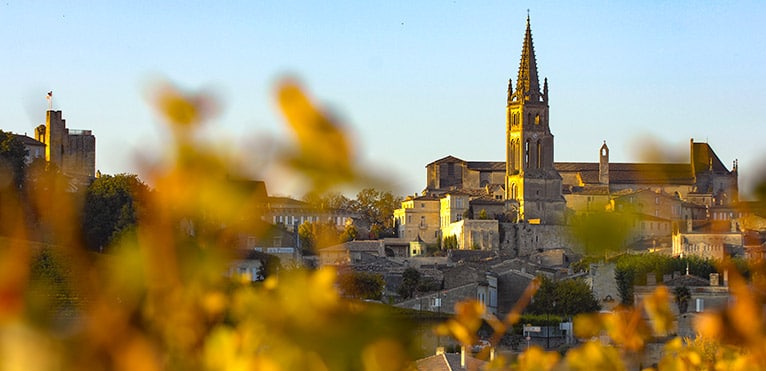
Contents
Saint-Émilion is a world-renowned appellation located in the Bordeaux region, in the Libournais sub-region. This Appellation d’Origine Protégée (AOP) and d’Origine Contrôlée (AOC) produces exclusively blended red wines. Its vineyards have been UNESCO World Heritage Sites since 1999.
Saint-Émilion has been cultivated since prehistoric times
The history of Saint-Émilion begins in the 1st century BC, when the first grape varieties from Massilia (Marseille) were grafted in the Saint-Émilion region. But in 97 AD, the Romans saw them as competition for Italian wines and put an end to Saint-Émilion’s winegrowing culture. At the end of the Roman Empire, Saint-Émilion began to flourish again until the 18th century, when the vineyard experienced an unprecedented increase in activity. Its recognized quality is due in no small part to the expertise of its owners at the time (e.g. Messrs Combret de la Nauze and Jacques Kanon). Today, the vineyard produces around 235,000 hectolitres a year.
In 1884, the winegrowers of Saint-Émilion created the second-largest winegrowers’ union in France, after Lalande-de-Pomerol, in a bid to unite against the difficulties they faced, notably diseases such as phylloxera, and to promote their terroir. In 1890, a second syndicate grouping together seven communes in the former jurisdiction of Saint-Émilion claimed their right to bear the appellation’s name. In 1914, the two unions merged, legitimizing the Saint-Émilion appellation for all these communes.
The appellation has been recognized since 1936 under strict specifications. In 1984, the appellation was split into two parts Appellations d’Origine Contrôlées: Saint-Émilion Grand Crus Classés and Saint-Émilion. The Saint-Émilion Grand Cru Classé charters, Saint-Émilion Grand Cru, Saint-Émilion Premier Grand Cru Classé and Saint-Émilion are thus to be distinguished. Saint-Émilion is not included in the 1855 crus classification and has therefore enjoyed a special status since the 1950s.
Saint-Emilion isone of the legendary appellations of the Bordeaux wine region.
Located on the right bank 35 km from Bordeaux, between Libourne and Pomerol, the Saint-Émilion vineyards extend over nine municipalities: Saint-Pey-d’Armens, Saint-Christophe-des-barbes, Saint-Émilion, Saint-Sulpice-de-Faleyrens, Saint-Etienne-de-Lisse, Saint-Hippolyte, Saint-Laurent-des-Combes, Vignonet and others.. The vineyard covers 5600 hectares on plateaux and valleys.
On the summits, the soil is asteriated limestone 10 to 15 meters thick, and on the slopes green clay, sand and molasses. To the south of the appellation, the soil is composed of sandy and gravelly terraces. The Saint-Émilion vineyards therefore boast an extraordinary variety of terroirs. There are four types of soil in the appellation: clay-loam, clay, limestone, and gravel and sand. The result is a wide variety of wines, each with its own special grain.
Saint-Émilion terroir produces a veritable nectar
The Saint-Émilion appellation produces exclusively blended red wines from Merlot , Cabernet Franc, Cabernet Sauvignon and a small minority of other grape varieties. Saint-Émilion wines have a deep ruby color with purplish highlights.
The nose is immediately striking, revealing aromas of red fruit, followed by delicate notes of spice, wood and roasting (such as cocoa). Saint-Émilion wines are quite robust on the palate, with a clean attack and a fine finish. These wines, which are very tannic in their youth, deserve to mature and soften, allowing them to develop beautiful notes of undergrowth and truffle. As a result, their ageing potential ranges from 5 to 15 years.
A Saint-Émilion goes wonderfully well with fine red meats or terrines.
Saint-Émilion wines are powerful and robust, with remarkable tannins in their youth. They go wonderfully well with many types of dishes, such as Easter lamb or duck aiguillettes with honey. More generally, it can be enjoyed with red meat, terrine or mushrooms. Saint-Émilion wine is best served at 17°.
2005, a fine vintage for Saint-Émilion
The Saint-Émilion appellation is renowned for its high-quality terroir and the exceptional work of its winegrowers. However, some vintages stand out from the rest and are proving to be even more qualitative. Such is the case with the 1982 and 2005 millennium vintages. Or the century vintages of 1990 and 2009. The years 1986 and 1989 were exceptional vintages.
Estates that respect tradition and the environment
Château Flouquet Invictus
The Château Floquet Invictus vineyard was founded in 1919 and extends over the communes of Saint Sulpice de Faleyrens and Saint-Émilion. Today, through the 5th generation, led by grandson David Bernard, the traditional culture of this exceptional terroir and above all ”
the passion and love of this precious nectar
“in his own words.
Château La Renommée
In 2014, Jean-Michel Bonnichon took over ownership of Château La Renommée. He joined forces with manager Jean-Noël Doublet and Chantal Sclafer, both great wine lovers, to produce between 50 and 60,000 bottles a year. Their philosophy can be summed up in a few words: encounter, quality, sharing, discovery, pleasure, curiosity.
With their customers’ satisfaction at heart, as well as their own pleasure in tasting their wine, the winegrowers are committed to cultivating the vineyard in the traditional way, without the use of chemical inputs, favoring green manures and preventive, reasoned treatments.
This 12-hectare Saint-Emilion estate is located mainly in the Saint-Emilion appellation area, but also in Castillon and Bordeaux. The soils are varied, including clay-limestone, sandy, sandy-clay and sandy-gravel depending on the plot.